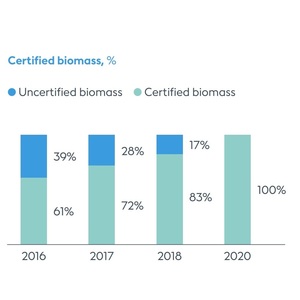Orsted highlights bioenergy achievements in new reports




SOURCE: Orsted
February 4, 2019
BY Erin Krueger
Denmark-based power producer Orsted has released 2018 financial results and published its 2018 sustainability report. Within both documents, the company highlights its bioenergy achievements and goals.
Within its annual report, Orsted reported that revenue for its bioenergy segment increased by DKK 500 million ($76.6 million) to DKK 6.4 billion last year.
Power generation for the bioenergy segment was 18 percent lower than in 2017, which Orsted attributed primarily to the divestment of its Dutch power plant. Power generation from the company’s Danish bioenergy plants increased by 4 percent, driven by higher spreads, while heat generation decrease slightly by 2 percent to 8.8 TWh in 2018 due to warmer weather, the company said.
Revenue from heat sales increased by 11 percent despite the decrease in heat generation. Orsted attributed the increase to the bioconversion of the Skaerbaek Power Station and higher revenue from the Avedøre Power Station due to its ramp up during the first quarter of 2017 following its bioconversion in 2016.
Revenue from power and ancillary services increased by 6 percent to DKK 3.5 billion, driven by a 45 percent increase in power prices when compared to 2017. ABITDA increased reached DKK 400 million, up DKK 200 million when compared to the previous year.
Advertisement
Advertisement
According to Orsted, its bioenergy division consists of the company’s combined-heat-and-power (CHP) generation business in Denmark, and its growth platform within green biogas and waste, Green Waste Solutions. The company’s CHP and heating plants provide approximately one quarter of Denmark’s district heating and approximately one-third of the country’s thermal power.
In its annual report, Orsted said its bioenergy segment is working to complete the conversion of its Danish CHP plants to biomass. The company plans to completely phase out coal by 2023. Orsted said it is also continuing to explore potential for growth and value creation within its waste-to-energy and biogas technologies.
According to Orsted, it is committed to the Sustainable Biomass Programme, a certification system for biomass. In 2018, the company said all of its biomass came from sustainable sources, mostly in the form of residues from timber production, such as sawdust, branches and thinnings. The company said 83 percent of the biomass it used last year was certified by third parties. By 2020, Orsted expects 100 percent of its biomass to be third-party certified.
In its annual report, Orsted said the biomass conversion of its Asnaes Power Station is progressing on schedule. The company currently expects the station to provide green district heating starting in 2020. The power station will also provide steam to Novo Nordisk’s and Novozymes’ production facilities. Orsted it is also progressing with its flue gas condensation project in Herning, which will allow the company to substantially increase the heat and power output of the biomass used from mid-2019 onwards.
In its sustainability report, Orsted said five of its seven CHP stations have already been converted from coal or gas to biomass. The Asnaes plant will be the sixth biomass conversion. The seventh CHP station, located in Esbjerg, will be closed by the end of 2022. Orsted said it has not been able to secure an agreement to convert that CHP station to run on sustainable biomass.
Advertisement
Advertisement
Orsted also provided an update of its Renescience facility in the U.K. that converts household waste into biogas and recyclable materials using enzymes and mechanical sorting technologies. According to the company, the Northwich, U.K.-based facility has confirmed that the core enzymatic sorting process works as expected. Orsted said it is currently finalizing the optimization of the plant’s mechanical operations. Final commissioning is expected during the first half of 2019.
Regarding its biogas operations, Orsted noted it now operations four major biogas-upgrading facilities in Denmark.
Overall, Orsted reported operating profit of DKK 30 billion for 2018, up from DKK 22.5 billion in 2017. Net profit was DKK 19.5 billion, up from DKK 13.3 billion in 2017. The green share of power generation reached 75 percent, up from 64 percent the previous year.
Copies of the 2018 annual report and 2018 sustainability report can be downloaded from Orsted’s website.
Upcoming Events





